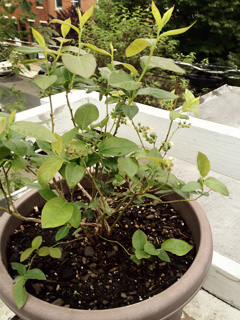 story by Char VandermeerI once took great pleasure in planning my flowering container garden. My imagination brimmed with bright annuals as I sketched plans and gathered supplies. I spent countless hours paging through seed catalogs, agonizing over varieties and colors, flowering times, watering requirements, height, greenery, grasses, vines and heaven knows what else. Although I’m still a sucker for a clump of bright cosmos, these days I’m all about eating what I grow. And if I only have to plant it once, even better.
story by Char VandermeerI once took great pleasure in planning my flowering container garden. My imagination brimmed with bright annuals as I sketched plans and gathered supplies. I spent countless hours paging through seed catalogs, agonizing over varieties and colors, flowering times, watering requirements, height, greenery, grasses, vines and heaven knows what else. Although I’m still a sucker for a clump of bright cosmos, these days I’m all about eating what I grow. And if I only have to plant it once, even better.
Blueberries are a logical choice and an ideal replacement in containers that formerly housed serena angelonia, dwarf snapdragons and trailing lobelia. They have shallow root systems and can live happily in 18-inch containers for the first two or three years. After that, assuming all goes well, they can be transplanted into 24-inch pots. Unless you have plenty of room and plan on potting enough plants to encourage cross-pollination, you’ll want to look for smaller, self-pollinating varieties like the dwarf Top Hat or smallish Sunshine Blue. Ask your supplier for plants that are two years old—the plants will be young enough for easy transplanting, but old enough that you might even see a few berries in your first year. Once your bushes reach maturity (three to five years old), you can expect a five to 10-pound berry yield per plant. And fret not, procrastinators; if you miss the late spring planting window, most nurseries will allow you to order now for fall planting.
Soil is where things get a little tricky. Blueberries require fairly acidic soil with a pH of 4.5 to 5.0, so look for a potting soil that’s formulated for acid-loving plants like azaleas or rhododendrons. Concoct a potting mixture of three parts high-acid soil, one part coco peat and one part fine pine bark. (The coco peat helps oxygenate the soil, while the pine bark provides nutrients and encourages adequate drainage.) Dump most of the mixture into the pot, leaving four inches or so below the rim. Gently remove the plant from its shipping container and loosen the roots. Place the blueberry plant on the soil and carefully shovel the remaining soil mixture around the root ball until soil is level with the top of the pot and roots of the plant. Take care not to bury the plant deeper than it was in the original shipping container. Water thoroughly and top with additional soil, if necessary. In three years or so, consider replanting in new soil.
Your new blues will need to be watered regularly. During the summer heat, plan on watering daily, but beware: consistently saturated soil will quickly lead to root rot. Mulch the plants with pine bark to keep the soil cool and moist, and fertilize with Holly-tone (or another acid-rich fertilizer) in the fall and spring. In mid-summer, when your plants begin fruiting, you may need to drape them in bird netting to keep the birds away, and when winter rolls around, add a fresh layer of mulch and wrap the plants in burlap to protect them from the coldest days Philly dishes out.
CHAR VANDERMEER tends a container garden on her South Philly roof deck; she chronicles the triumphs and travails at plantsondeck.com



A very nice advice. i wanted to grow blue berries for so long. could this plant be put inside a house and place it besides a window?
A very nice advice. i wanted to grow blue berries for so long. could this plant be put inside a house and place it besides a window?
I’m only going to use peat (for acidity) on blueberry bushes, but I’m now using coir in pots (mixed with homemade compost and other ingredients, of course).
I’m only going to use peat (for acidity) on blueberry bushes, but I’m now using coir in pots (mixed with homemade compost and other ingredients, of course).